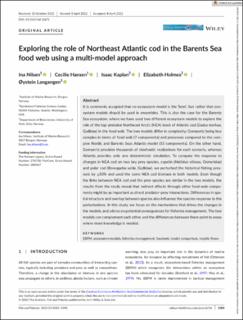| dc.contributor.author | Nilsen, Ina | |
| dc.contributor.author | Hansen, Cecilie | |
| dc.contributor.author | Kaplan, Isaac | |
| dc.contributor.author | Holmes, Elizabeth | |
| dc.contributor.author | Langangen, Øystein Ole Gahr | |
| dc.date.accessioned | 2023-01-17T11:10:30Z | |
| dc.date.available | 2023-01-17T11:10:30Z | |
| dc.date.created | 2022-10-11T14:31:52Z | |
| dc.date.issued | 2022 | |
| dc.identifier.citation | Fish and Fisheries. 2022, 23 (5), 1083-1098. | en_US |
| dc.identifier.issn | 1467-2960 | |
| dc.identifier.uri | https://hdl.handle.net/11250/3043955 | |
| dc.description.abstract | It is commonly accepted that no ecosystem model is the ‘best’, but rather that ecosystem models should be used in ensembles. This is also the case for the Barents Sea ecosystem, where we have used two different ecosystem models to explore the role of the top-predator Northeast Arctic (NEA) stock of Atlantic cod (Gadus morhua, Gadidae) in the food web. The two models differ in complexity; Gompertz being less complex in terms of food web (7 components) and processes compared to the complex Nordic and Barents Seas Atlantis model (53 components). On the other hand, Gompertz provides thousands of stochastic realizations for each scenario, whereas Atlantis provides only one deterministic simulation. To compare the response to changes in NEA cod on two key prey species, capelin (Mallotus villosus, Osmeridae) and polar cod (Boreogadus saida, Gadidae), we perturbed the historical fishing pressure by ±50% and used the same NEA cod biomass in both models. Even though the links between NEA cod and the prey species are similar in the two models, the results from the study reveal that indirect effects through other food-web components might be as important as direct predator–prey interactions. Differences in spatial structure and overlap between species also influence the species response to the perturbations. In this study, we focus on the mechanisms that drives the changes in the models, and advise on potential consequences for fisheries management. The two models can complement each other, and the differences between them point to areas where more knowledge is needed. | en_US |
| dc.language.iso | eng | en_US |
| dc.title | Exploring the role of Northeast Atlantic cod in the Barents Sea food web using a multi-model approach | en_US |
| dc.title.alternative | Exploring the role of Northeast Atlantic cod in the Barents Sea food web using a multi-model approach | en_US |
| dc.type | Peer reviewed | en_US |
| dc.type | Journal article | en_US |
| dc.description.version | publishedVersion | en_US |
| dc.source.pagenumber | 1083-1098 | en_US |
| dc.source.volume | 23 | en_US |
| dc.source.journal | Fish and Fisheries | en_US |
| dc.source.issue | 5 | en_US |
| dc.identifier.doi | 10.1111/faf.12671 | |
| dc.identifier.cristin | 2060537 | |
| dc.relation.project | Norges forskningsråd: 276730 | en_US |
| dc.relation.project | Norges forskningsråd: 280467 | en_US |
| cristin.ispublished | true | |
| cristin.fulltext | original | |
| cristin.fulltext | original | |
| cristin.qualitycode | 2 | |
